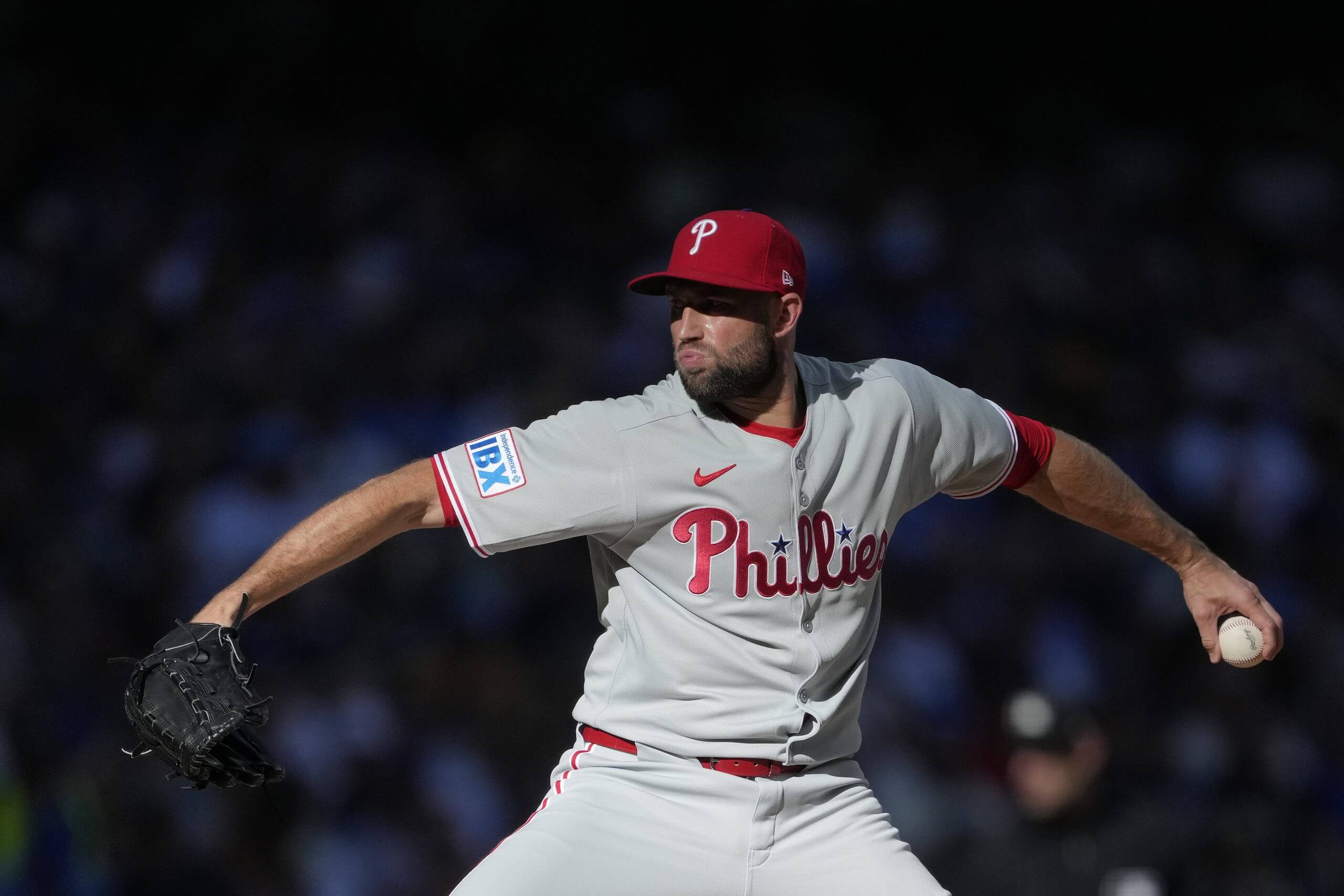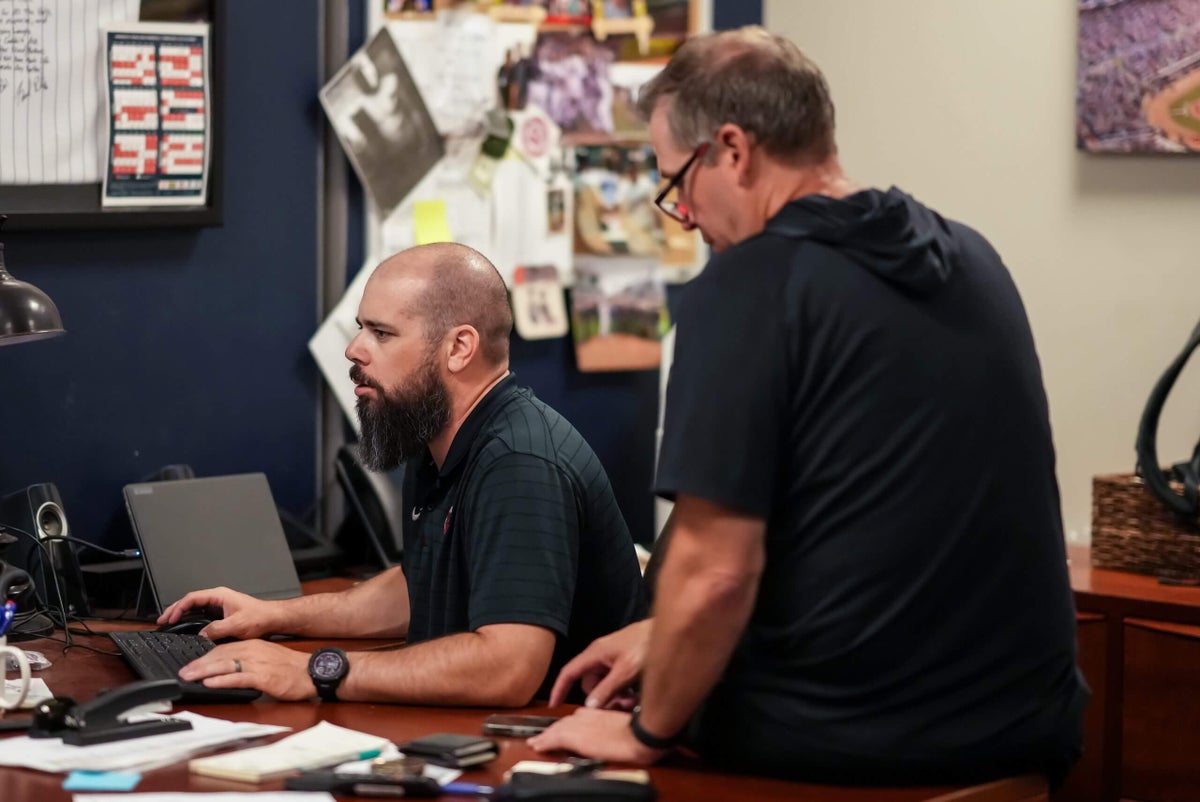MINNEAPOLIS — Getaway days typically are frantic for Major League Baseball clubhouse attendants. Their schedules are highlighted by a lightning-quick postgame breakdown of the locker room, where each player’s game bag is packed and accounted for and every piece of equipment is properly stored for an upcoming trip.
Duffel bags full of gloves, hats and sunglasses cases are transferred by hand, while dollies loaded with boxes of every tool a baseball team could need on the road fly down corridors to a truck that is eventually headed for the airport, where it will meet the team plane.
Those days are hardly ideal for communication between rival clubbies about the hat and jersey sizes or the shoe company with which a new player has a contract. But when he was faced with that scenario on Aug. 31, his team having claimed left-handed reliever Tim Mayza off waivers from the Pittsburgh Pirates, Philadelphia Phillies director of clubhouse services Phil Sheridan turned to an easy solution for all the information he sought.
Knowing his Pirates counterpart was dealing with the same logistical challenges of a getaway from the cramped confines of Fenway Park, Sheridan logged into an app available to all 30 teams. It lists hat sizes, waist measurements and inseams, in a database created by Minnesota Twins home clubhouse assistant manager Tim Burke.
“It’s phenomenal,” New York Yankees visiting clubhouse manager Lou Cucuzza Jr. said. “It covers the coaching staff, it covers the minor leagues. You can search anybody in baseball. The saving grace is, especially if in the offseason, you add 10 different players, now you don’t have to call five to six different clubs (for sizes). You just go to the app and you’ve got everything. You got the shoe company he uses, the glove company, size of T-shirt, shorts.”

Preparing a jersey for Tim Mayza’s arrival this month with the Phillies was made easier by an app created by a Twins clubhouse attendant. (Patrick McDermott/Getty Images)
Asked about his invention, one he initially created for the Twins only in 2018 after teaching himself how to code, Burke jokes it’s “boring.” Initially, Burke considered creating a spreadsheet full of information for Twins players, a handy tool he and the team’s other clubbies could use to make the start of spring training easier.
Every year, teams invite 60 to 70 players to spring training — an assortment of major leaguers, prospects and even minor-league invitees hoping to impress their new organization and win a spot on the 26-man roster. Before Burke created the app, the team didn’t keep records of its players’ sizes. Every season, Twins clubhouse attendants spent an entire day tracking down such player details, a process he estimates took at least 10 minutes per athlete and longer for more challenging ones.
“If some guys were really picky about their pants, it might take 15 minutes,” Burke said.
Hoping to optimize the clubhouse staff’s time, Burke, employed by the Twins since August 2000, thought about creating an app. Cucuzza, who has worked for the Yankees since 1978 and has been the president of the MLB Clubhouse Managers Association for 14 years, encouraged him.
“I told him that’s a great idea,” Cucuzza said.
With a background in computers because of his father’s career in the industry, Burke decided to teach himself how to code. He spent a year learning the Python programming language from a book he purchased in 2015.
Burke put it to the test during the 2017 season and again in 2018. Around that time, Burke recognized he could potentially connect his system with one used to track major-league transactions, which would allow for expanded use around the sport.
“Every year, we had everybody come through and give us the sizes and try it on,” Burke said. “If you don’t know, try it on. … It’s a tool for the job, just to make it more efficient. I built it with the intent to help us (the Twins) originally. But when I realized I could build the framework around it that would help all the equipment managers, it was a pretty exciting moment.”
Once he discovered how he could integrate MLB’s system with his own, Burke again contacted Cucuzza. The MLBCMA then spoke with the league to facilitate access, and the system Burke still continually updates was created. Cucuzza invited Burke to address the MLBCMA at baseball’s annual winter meetings in December 2018.
While clubbies rave about the app, they all noted a singular limitation. The entire system is dependent upon participation, and not all 30 teams use it. Burke thinks about half of the teams do, while Cucuzza estimates at least 20.
Both hope more will join, though they recognize it takes some level of buy-in because information must be manually inputted. The system also becomes far more effective if an organization’s minor-league clubhouse attendants insert measurements for their players.
Even with less than full participation, the system is more helpful than what teams receive from Fanatics, the company responsible for providing teams with uniforms. Fanatics keeps jersey and pants sizes on file only because it’s all the company is responsible for with teams.
“(The app) has everything else,” said Brandon Biller, assistant home clubhouse manager for the Cleveland Guardians. “Helmet, shoes, contracts with shoe companies, batting gloves, all of that is in there. You can search all 30 teams and you can also see Double A, Triple A. We use it, so we input all of the information in spring training. We don’t necessarily stay up on it as the season goes on, or as a guy changes something. … (Burke) has taken it pretty far.”
Burke benefited greatly from his own system seven weeks ago. He was the team’s clubhouse attendant on an early August trip to Cleveland and Detroit that began the day of the July 31 trade deadline. While Burke expected some movement after the Twins traded Jhoan Duran and Chris Paddack earlier in the week, there was no way to anticipate the team trading eight more players off the major-league roster after the Twins had arrived in Cleveland.
Turns out being new to the major-league club wasn’t all the eight new arrivals had in common.
“Every guy we called up had 7 3/8 for their hat size,” Burke said. “I literally had zero left. We typically travel with eight of that size and I gave them all out. I had to overnight us some hats to backfill what I gave out.”
Though he jokes that it’s boring, Burke is proud of his app, especially as more teams use it. As the admin, he can see which teams do and don’t, based on the logins. He loves how the system performs since its integration with MLB’s transactions platform and how much easier that has made the process.
Burke admits it’s still not perfect; information gets stale. Players might gain or lose weight over the course of a season. Hat sizes change. Shoe, glove and bat contracts change.
But the system always works as intended.
Sheridan discovered the app three seasons ago when he and Burke discussed it at the winter meetings. Every spring, the Phillies create a spreadsheet of their players’ info and import it into the app. They update it throughout the season in hopes that everyone’s info is available.
After he logged in recently, Sheridan was pleased to discover Mayza’s information already in the system. About to leave Philadelphia for a six-game road trip to Milwaukee and Miami, Sheridan made sure the team brought additional gear for its new player.
“We use it whenever we call somebody up, make a trade,” Sheridan said. “It’s a good first step. Say you make a trade on the weekend, or late at night. You can’t call Fanatics or the guy on the other team. Let me check real quick on there and it gives you a starting point.”
— The Athletic’s Matt Gelb and Zack Meisel contributed to this story.
(Photo: Brace Hemmelgarn / Twins)
